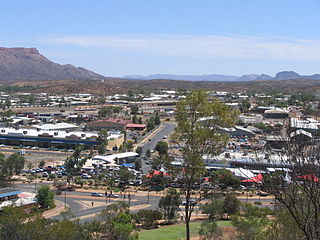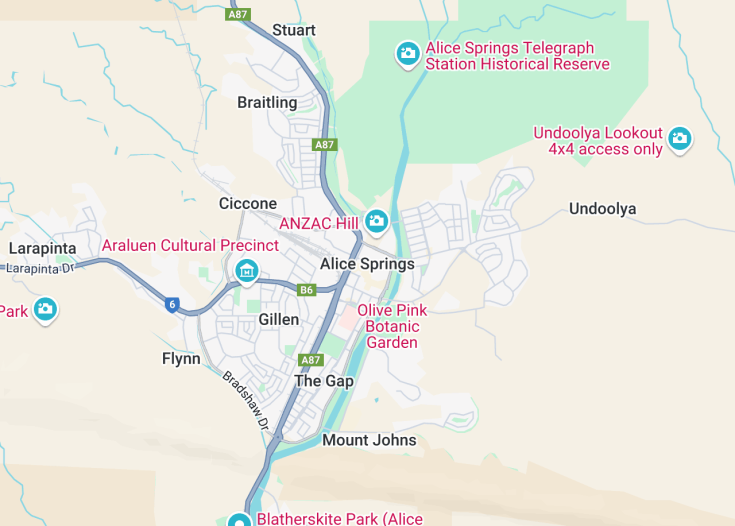Alice Springs, located in the heart of Australia’s Red Centre, is a captivating destination that embodies the spirit of the outback. Renowned for its vibrant indigenous culture, breathtaking landscapes, and iconic landmarks such as Uluru and Kings Canyon, Alice Springs offers a unique blend of historical richness and contemporary culture. Visitors can explore the rugged natural beauty of the MacDonnell Ranges, delve into the fascinating history at the Alice Springs Desert Park, or experience the renowned Larapinta Trail. This town is not just a gateway; it’s a deeply enriching cultural junction that makes an indelible mark on its visitors.
Visiting between April and September offers cooler temperatures and a chance to witness spectacular desert blooms and lively cultural festivals.
Make sure to spend a night camping under the star-studded outback sky for an unforgettable experience of the Australian wilderness.
Top things to do & see in Alice Springs
Select the following sights and activities to discover best tickets and tours available in Alice Springs.
Alice Springs: Heart of the Red Centre
| Country | Australia |
| Time in Alice Springs | GMT+9:30 |
| Language spoken | English |
| Population | 26,534 (Based on 2021 Census) |
| Currency | Australian Dollar (AUD $) |
| Airports | Alice Springs Airport (7.4 mi / 11.9 km) |
Alice Springs, located in the heart of Australia’s Red Centre, serves as a gateway to exploring the outback’s unique natural landscapes and Aboriginal culture. Nestled between the East and West MacDonnell Ranges, Alice Springs offers a combination of historic significance, vibrant indigenous culture, and striking natural beauty. This town is not just a tourist hub; it plays an essential role in the region’s economy, especially in mining and agriculture.
The town owes its origins to the pioneering efforts during the construction of the Overland Telegraph Line which linked Darwin to Adelaide and thereby the global telegraph network in the 19th century. This historical event marked Alice Springs as a crucial site in Australia’s development. Nowadays, it’s known for its spectacular desert landscapes, rich Aboriginal art scenes, and significant landmarks such as the Royal Flying Doctor Service, the School of the Air, which provides education to remote children, and the Telegraph Station Historical Reserve.
Moreover, the town is a favourite starting point for visitors heading to iconic natural attractions, including Uluru, the Olgas, and Kings Canyon. The unique flora and fauna, alongside the deeply entrenched cultural heritage of the Aboriginal communities like the Arrernte people who have lived in the Central Australian desert in and around Alice Springs for more than 50,000 years, make the town a profound place for both educational and recreational visits.
Alice Springs also hosts several internationally recognized events such as the Finke Desert Race, a grueling multi-day off-road event for bikes and vehicles, and the Beanie Festival, which showcases hand-crafted beanies – combining art, culture, and a sense of community. These events attract thousands of visitors annually and reflect the spirited, diverse community of Alice Springs.
With its vibrant community, rich history, and prime location amidst the stunning landscape of the Australian Outback, Alice Springs continues to be a place where the traditional and modern coexist. It’s a town that offers more than just a picturesque view; it’s a place where the history, culture, and the spirit of adventure thrive.
Where is Alice Springs?
Alice Springs is situated roughly in the geographical center of Australia, almost equidistant from Adelaide and Darwin.
Distances:
| Route | Distance by car | Time by car |
|---|---|---|
| Alice Springs to Darwin | 1497 km | 14h 40m |
| Alice Springs to Adelaide | 1531 km | 15h 40m |
| Alice Springs to Perth | 3654 km | 37h 20m |
What is Alice Springs famous for?
Alice Springs is famous for being a cultural hub in the heart of Australia’s Red Centre, known for its Indigenous art galleries, unique wildlife, and as the gateway to exploring famous outback landmarks like Uluru and Kings Canyon.
History
Before 1872: Indigenous Heritage
The area now known as Alice Springs has been inhabited by the Central Arrernte people for thousands of years. The site was a significant meeting place and the home to abundant waterholes and food sources, ideal for the nomadic lifestyle of the indigenous inhabitants.
1872-1930s: European Settlement and the Telegraph Station
Alice Springs began as a European settlement when the Overland Telegraph Line was constructed in the late 19th century. A telegraph station was built near a waterhole that surveyor William Whitfield Mills mistakenly thought was the source of the Todd River; he named it Alice Springs after Alice, Lady Todd, the wife of the telegraph pioneer Sir Charles Todd. The establishment of the telegraph station brought the first permanent European residents to the area.
1930s-1950s: Growth and Development
During the 1930s, Alice Springs gradually developed as more government services were established in the area to support the growing population. The construction of the railway line to Darwin in the late 1920s also contributed significantly to the growth of Alice Springs. World War II further influenced its development, as the town became an important base for military operations in Northern Australia.
1950s-Present: Modernization and Tourism
In the decades following World War II, Alice Springs underwent a period of modernization with improved infrastructure, healthcare, and education facilities. The discovery of nearby uranium brought economic growth. Tourism also began to thrive, with visitors drawn to the area’s stunning landscapes and rich indigenous culture. Today, Alice Springs is a vibrant town that serves as the gateway to the iconic outback experiences of central Australia.
Visit Alice Springs
What to see and do in Alice Springs
Explore the vibrant heart of Australia’s Red Centre in Alice Springs. This unique town offers a mix of stunning natural landscapes and rich cultural heritage. Visitors can explore the MacDonnell Ranges, which stretch both east and west of the town, offering beautiful scenery and hiking opportunities. The Alice Springs Desert Park provides a deep dive into the desert environment, flora, and fauna, while the Aboriginal Art galleries showcase some of the best indigenous art in the country.
- Visit the historic Telegraph Station.
- Explore the Alice Springs Desert Park.
- Walk through the Olive Pink Botanic Garden.
- Experience the thrill of a hot air balloon ride over the Outback.
- Learn about local history and culture at the Araluen Cultural Precinct.
Festivals and Events
Alice Springs hosts a variety of cultural and sports events throughout the year that reflect its vibrant community spirit. The Beanie Festival in June celebrates quirky and creative handmade beanies, while the Henley-on-Todd Regatta, held in August, is a boat race with a unique twist—there’s no water! The desert race is both a spectacle and a testament to Aussie humor and ingenuity.
Best time to visit Alice Springs
The best time to visit Alice Springs is during the cooler months from April to September. During this period, the daytime temperatures are pleasant, which is ideal for exploring the natural landscapes and participating in outdoor activities.
Is Alice Springs worth visiting?
Alice Springs is undoubtedly worth visiting. It offers a unique blend of geographical beauty, deep cultural roots, and a wide range of activities, making it a compelling destination for those interested in exploring life in the Australian Outback. Whether you’re an adventure seeker, a nature lover, or a culture enthusiast, Alice Springs provides a memorable and enriching experience.









